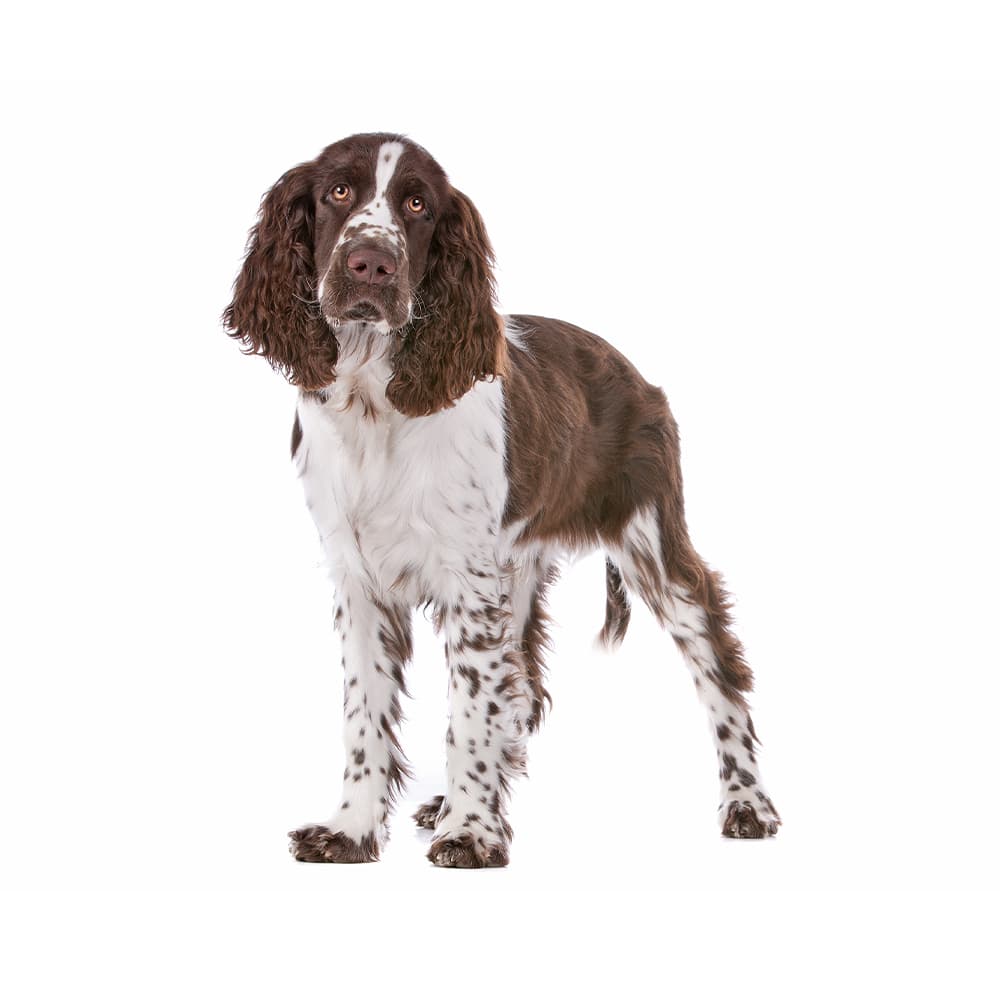Discover your dog's connection to this breed and 200+ others


Discover your dog's connection to this breed and 200+ others



The English Springer Spaniel traces its origin back to the mid-19th century England. Originally bred as a gun dog to flush, or ""spring,"" game in the field, the breed is thought to be descended from the Norfolk or Shropshire Spaniels. Springer Spaniels would work with their hunters to bring down their prey with nets, falcons or bows. Their job was to detect birds in high grass and flush the birds from their cover, and lastly to retrieve the bird after it was downed. The breed has since been used in K-9 detective work because of their trainability, strength, and keen nose. The English Springer Spaniel was recognized by the Kennel Club of England in 1902, distinguishing it as a separate breed from English Cockers. The American Kennel Club (AKC) recognized the English Springer Spaniel as a breed in 1910.
English Springer Spaniels can suffer from elbow or hip dysplasia, progressive retinal atrophy, otitis externa, phosphofructokinase (PFK) deficiency, and retinal dysplasia. Genetic testing for these and other conditions such as acral mutilation syndrome, degenerative myelopathy, familial nephropathy, fucosidosis, glycogen storage disease VII, cone-rod dystrophy 4, and chondrodystrophy and intervertebral disc disease (CDDY and IVDD risk) with or without chondrodysplasia (CDPA) is recommended to assist veterinarians with diagnosis and proactive care, as well as help breeders identify affected and carrier dogs.
English Springer Spaniels are known for their friendly, eager-to-please demeanor. They are quick learners and are generally known to get along well with children and other pets. However, they require plenty of exercise due to their working dog heritage, and can become destructive when bored. Early socialization and obedience training is recommended for this breed.
A canine genetic lineage is a group of individuals or entire breeds that descended from common ancestors predating modern breed formation. Often these lineages are associated with a ‘type’ of dog with a unique historical working role and associated behaviors (e.g., herding, scent hunting, etc.).
The Pointer-Spaniel lineage encompasses both pointer and spaniel breeds. They were both bred for their specialized hunting abilities in Europe. Pointers locate game and freeze in a stance, called “pointing”, to indicate to their hunter that birds are close by. Spaniels were bred to find game in underbrush and retrieve it. Both pointer and spaniel breeds were bred to enhance their strong senses, trainability, and endurance as these are advantageous in a hunting partner. Spaniels and pointers are known for their strong work ethic, ability to work closely with humans and agility. These dogs’ ability to work closely with their hunters makes them an asset during a hunt because they follow direction well and know how their hunters want them to proceed.
Example breeds with ancestry from this lineage include English Cocker Spaniel, Irish Red Setter, and German Shorthaired Pointer.
Despite their friendly nature, English Springer Spaniels are still often used as working dogs in police departments for drug detection, and as search and rescue dogs.
They are often divided into two types: show dogs and working (field) dogs, with the latter typically having a leaner body and shorter coat.
The English Springer Spaniel is the ancestor to all modern spaniels, including the English Cocker Spaniel and the Clumber Spaniel.
https://www.akc.org/dog-breeds/english-springer-spaniel/
https://www.fci.be/en/nomenclature/ENGLISH-SPRINGER-SPANIEL-125.html
https://www.ukcdogs.com/english-springer-spaniel
https://www.pawprintgenetics.com/products/breeds/60/
https://www.petmd.com/dog/breeds/c_dg_english_springer_spaniel
Recommended by top vets with decades of experience
21 breeds
64 genetic health markers
50 genetic trait markers
